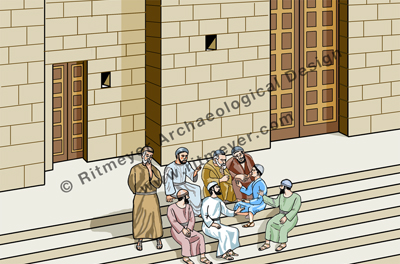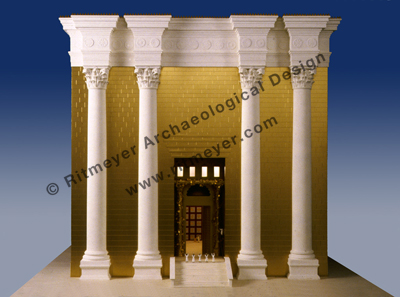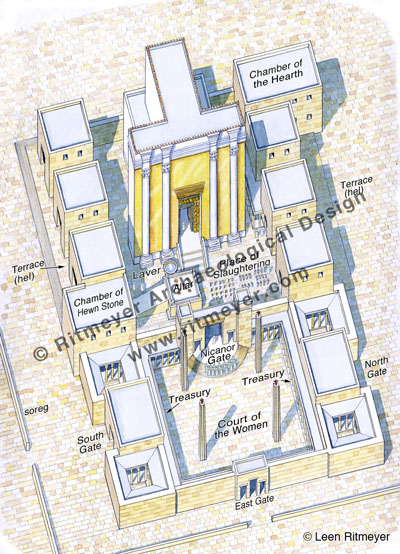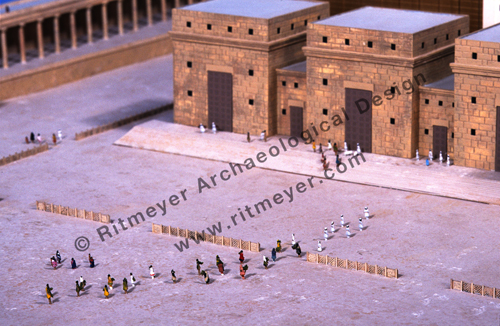On Sunday, the 10th of April, 2017, the Jewish people begin celebrating Pesach – Jewish Passover. That is one week earlier than Easter. However, in this blog post we would like to remember the time that Jesus as a twelve-year-old visited the Temple during Passover for the first time in his life.

The Temple in the time of Christ was a magnificent building. From the Temple Court (azarah), 12 steps led up to the Porch that was as high as the Temple itself. In front of the entrance to the Sanctuary, a Golden Vine was attached to four columns.

No wonder that some of Jesus’ disciples remarked “how the Temple was adorned with beautiful stones and with gifts dedicated to God” (Matthew 24.1; Luke 21.5).
The central feature of this complex, the Holy of Holies, was located deep inside, at the west end of the Sanctuary. No one could enter this place of utmost sanctity but the High Priest once a year on the Day of Atonement. A veil separated the Holy of Holies from a place of lesser sanctity, the Holy Place.
The Temple Court lay in front of the Temple and it contained the Altar, the Laver and the Place of Slaughtering (or Shambles). This was the closest court to the Temple and out of bounds to anyone like Jesus who was not a priest.

This Temple Court was separated by the Nicanor Gate from the Court of Women, which lay to the east of the Temple. Buildings, called gates, surrounded this complex. In front of the gates was a terrace (ḥel – pronounced chel with the “ch” sounding guttural as in the Scottish “loch”) of 10 cubits wide, which was reached by a flight of steps of half a cubit high and deep. This terrace bounded the wall of the gate buildings on their southern, western and northern sides.

It is on this ḥel that we get our first glimpse of Jesus after the birth narratives in the Gospels. Scripture is silent about his youth although it is clear from the observations of nature and Biblical history later attributed to him by the Gospel writers that he absorbed every spiritual and historical lesson that was provided by his upbringing in the countryside around Nazareth.
Now he was twelve years of age and his first words are recorded for us (Luke 2. 41-52). Under the law, attendance at the feasts in Jerusalem was obligatory for boys from the age of thirteen, a birthday that was a milestone in the life of a Jewish boy, when they became a Son of the Commandment or Bar Mitzvah. In practice, this legal age was pushed forward by one or two years so that Jesus, after he had passed his twelfth year, came up to Jerusalem for the Passover with his family. Jesus’ first view of the Temple must have filled him with a great sense of the purpose he had been developing during the quiet years in Nazareth. Attendance at the Temple was obligatory only for the first two days of Passover, after which many of the pilgrims would have returned home again. It would appear that Joseph and Mary and their “company” did indeed start to return home and had travelled for a day. When they finally realized that Jesus was missing, it took them three days to find him and when they did, he was “in the temple, sitting in the midst of the doctors, both hearing them and asking them questions.” The ḥel is the only place in the Temple he could have been.
We learn this from a tractate of the Babylonian Talmud, Sanhedrin 88b, which tells us:
“It has been taught; R. Jose said; Originally there were not many disputes in Israel, but one Beth din of seventy-one members sat in the Hall of Hewn Stones, and two courts of twenty-three sat, one at the entrance of the Temple Mount and one at the door of the [Temple] Court, and other courts of twenty-three sat in all Jewish cities.” “The Great Sanhedrin] sat from the morning tamid (daily sacrifice) until the evening tamid [in the Hall of Hewn Stones]; on Sabbaths and festivals they sat within the ḥel.”
So, Passover would have been one such festival when members of the Temple Sanhedrin would come out to teach in this area. Ordinary people, who normally had no access to the classrooms where young priests were taught, could come and question them. Jesus must have eagerly made use of this opportunity and never would they have had such a sharp student as him. During this visit to the Temple, he would have seen the preparations for sacrificing the Passover lambs and realized, perhaps for the first time in his young life, that the entire ritual pointed forward to his own sacrifice. He would have been so absorbed by all these experiences that he would not have wanted to leave. He forgot about his natural family, for here he was at home – in his Father’s house.

A very nice and beautiful analysis, even if, as a non-Christian, my view of things is, shall we say, slightly different. 🙂
It should pointed out that today, it’s very common for Jewish boys to begin formally observing all the laws a bit before their 13th birthday, and girls before their 12th. Obviously they’ve been introduced to them from a much younger age, but, for example, they may start observing the fasts from the age of 11 or so, and start putting on phylacteries anywhere from a month to a year or more before their birthday. It’s possible that Joseph and Mary thought that a trip from Nazareth to Jerusalem was a bit much for, say, a seven year old Jesus, but twelve was considered a good age to start.
A few questions:
-What do you mean by “obligatory for the first two days”? Do you mean the 14th (the day the Passover offering was brought) and the 15th (the first actual day of the festival)? Otherwise you’d either stay for the whole week or leave on the 16th, and we know that many people did, indeed, stay the week. (This could be different if, say, the first day of Passover was on a Saturday that year.) Solomon sent the people home after only a whole week of Sukkot, and the Talmud says pilgrims from Babylon left after a week. Maybe those who lived closer didn’t see a great pull to stick around. This is true to this day. 🙂
The Chamber of Hewn Stone was within the wall of the Temple Court and thus theoretically open to anyone. (Emphasis on the “theoretically.” Probably 12-year-old boys wouldn’t be permitted.) In addition, it was the High Court/legislature, not a “classroom for young priests,” which were nearby but elsewhere. However, it’s certainly true that access would have been wider when they sat on the hel.
One last point: “Afternoon tamid” would be more accurate than “evening tamid,” I would think.
It’s interesting but we talk about the silent years, between the return from Egypt up to the fasting in the wilderness. The visit at 12 years old to the temple is the only glimpse we get between these two events in the Lord Jesus Christs life. Is this His first visit to Jerusalem from Nazareth as a child? we’re not told, and did He continue to yearly go to Jerusalem for the passover after this recorded event?
Tom, according to Luke 2:41, Joseph and mary went every year to Jerusalem at Passover. It is therefore reasonable to suggest that Jesus would have continued to do the same. There is much more to learn about the “silent years” from the place where Jesus grew up, biblical geography, the education of his ‘parents’ and his observant and inquisitive mind.
According to theologian Dr. David Black, the reason why Jesus went to the Feast of Passover at age 12 is because that is when he became a man. Even according to the custom, Jesus would of traveled up with the women and children as a representation of his childhood, but he would of traveled back with the men representing his manhood. This explain how come he was lost from His parents…..because he was separated while coming back with the men.
St Luke states [2:46] that Jesus was “kathezomenon en meso,” a verb form from the same root as Kathedra. Does this not suggest that Jesus is “chaired” – “in the center”? – A very formal setting, indeed! He isn’t on the floor or a step, looking up at them, but in the Teacher’s position! “Hearing them and *posing questions* for them” — truly astonishing them, “with his [rabbinical/teaching] Questions and his *Judgments*”? Perhaps the leading rabbi has yielded his own chair to Him? St Luke is presenting JESUS as Incarnate Wisdom, before his Bar Mitzvah, it would seem.
Where did the Holy Family stay? May I make this suggestion:
Elizabeth, mother of John Baptist, was ‘of the daughters of Aaron’ & a relation of the Blessed Virgin Mary. She probably grew up on Mount Zion herself. If so, the extended family were probably welcomed to the same palatial home annually for the Seder. Is it possible this is the same mansion with the “large upper room, furnished” in 33AD?
“kathezomenon” simply means “sitting”. It indicates the relationship between teacher and student. Saul was brought up “at the feet of Gamaliel” (Acts 22:3). Gamaliel, as teacher, stood, and Saul, as student, sat. That was normal in the ancient Near East. After he was healed, Legion was “sitting at the feet of Jesus”. He now listened to the teacher. Mary the sister of Martha did the same (Luke 10:39).
The doctors of theology of Jesus’ time were astonished indeed, but they didn’t use a special throne or chair to speak from. They didn’t speak “ex cathedra”, neither did Jesus. It is important to use primary sources, such as the Bible, the Work of Josephus and the Mishnah to create a realistic picture of this scene. There is no point imposing our 21th century understanding or church traditions on a 1st century scene, which is so accurately described by both Josephus and the Mishnah, as mentioned in this post.
My drawings are not as artistic as those created by the master painters of the Middle Ages, but at least they are based, not on wishful thinking and church tradition, but on archaeological evidence and the appropriate historical sources, and therefore accurate!
Both Elizabeth and Zecharias were descendants of Aaron the High Priest. They lived in a city of Juda, in the hill country (Luke 1:39). That is not Jerusalem, let alone Mount Zion. Aaron was given the city of Hebron, in the hill country of Judah (Joshua 21:11-13). Only Hebron qualifies as a “city in the Hill Country of Judah”, and that is where Mary visited Elisabeth (Luke 1:36.40).
“The doctors of theology of Jesus’ time were astonished indeed, but they didn’t use a special throne or chair to speak from. They didn’t speak ‘ex cathedra’, neither did Jesus. It is important to use primary sources…”
.
This primary source says they did:
.
“Mat 23:2 Saying, The scribes and the Pharisees sit in Moses’ seat:
Mat 23:3 All therefore whatsoever they bid you observe, that observe and do; but do not ye after their works: for they say, and do not.”
.
As you surely know, the chair of Moses was the place of authority that the Scribes and Pharisees had in interpreting The Law and exercising their authority over the Jewish people. In Greek, the phrase is Moses kathedras, literally “Moses’ seat.” It is translated both ways throughout translations. That’s exactly where Catholics get ex cathedra – we let the Bible impose itself on our traditions, rather than imposing our traditions on the Bible – we retain ex cathedra in certain cases with special parameters because Jesus told them to do as they taught, but not follow their hypocritical example. Jesus understood and submitted to Jewish authority.